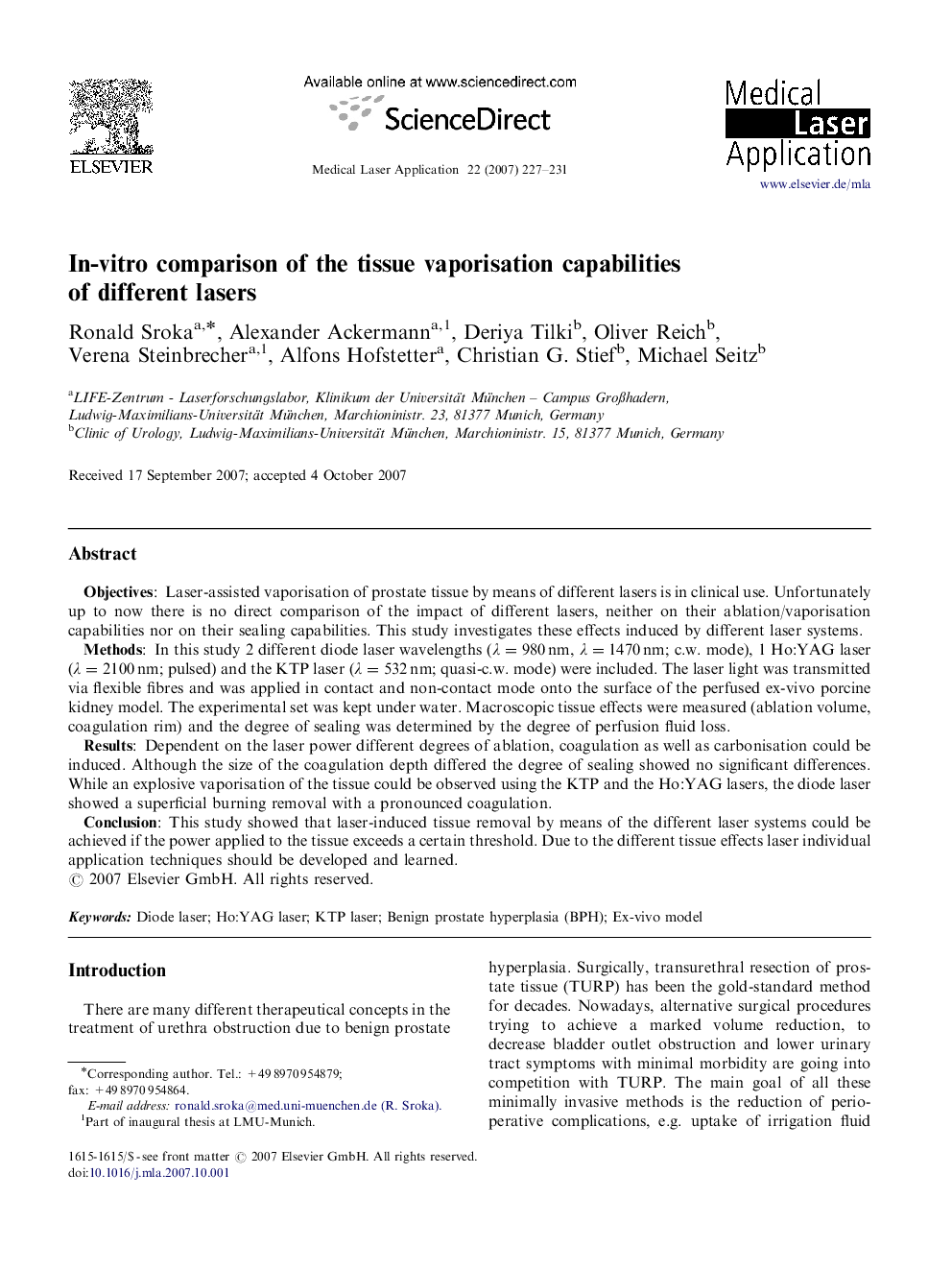| کد مقاله | کد نشریه | سال انتشار | مقاله انگلیسی | نسخه تمام متن |
|---|---|---|---|---|
| 2068382 | 1544394 | 2008 | 5 صفحه PDF | دانلود رایگان |

ObjectivesLaser-assisted vaporisation of prostate tissue by means of different lasers is in clinical use. Unfortunately up to now there is no direct comparison of the impact of different lasers, neither on their ablation/vaporisation capabilities nor on their sealing capabilities. This study investigates these effects induced by different laser systems.MethodsIn this study 2 different diode laser wavelengths (λ=980 nm, λ=1470 nm; c.w. mode), 1 Ho:YAG laser (λ=2100 nm; pulsed) and the KTP laser (λ=532 nm; quasi-c.w. mode) were included. The laser light was transmitted via flexible fibres and was applied in contact and non-contact mode onto the surface of the perfused ex-vivo porcine kidney model. The experimental set was kept under water. Macroscopic tissue effects were measured (ablation volume, coagulation rim) and the degree of sealing was determined by the degree of perfusion fluid loss.ResultsDependent on the laser power different degrees of ablation, coagulation as well as carbonisation could be induced. Although the size of the coagulation depth differed the degree of sealing showed no significant differences. While an explosive vaporisation of the tissue could be observed using the KTP and the Ho:YAG lasers, the diode laser showed a superficial burning removal with a pronounced coagulation.ConclusionThis study showed that laser-induced tissue removal by means of the different laser systems could be achieved if the power applied to the tissue exceeds a certain threshold. Due to the different tissue effects laser individual application techniques should be developed and learned.
ZusammenfassungHintergrundDie Laservaporisation der Prostata ist eine klinisch erprobte Methode zur Therapie der benignen Prostata Hyperplasie. Leider existiert kein Vergleich der einzelnen verwendeten Lasertypen in Bezug auf den Abtrag und die induzierten Koagulationsbereiche. Ziel dieser Arbeit ist es, mit einem experimentellen Ansatz die durch unterschiedliche klinische Lasertypen induzierten Schädigungen zu vergleichen.Material und MethodeFür diese Studie wurden 2 unterschiedliche Diodenlaser (λ=980 nm, 1470 nm; c.w. mode), ein Ho:YAG laser (λ=2100 nm; gepulst) und der KTP-Laser (λ=532 nm, quasi-c.w. mode) getestet. Das Laserlicht wurde in flexible Lichtwellenleiter eingekoppelt und im Kontakt-und Nicht-Kontakt Verfahren auf die Oberfläche des perfundierten Schweinenieren-Modells appliziert. Die Experimente wurden in einem temperierten Aquarium durchgeführt. Die makroskopischen Gewebeeffekte wurden vermessen (Ablationstiefe, Koagulationssaumbreite) und der Grad der Versiegelung mittels Bestimmung des Verlustes an Perfusionsflüssigkeit ermittelt.ErgebnisseAbhängig von der Laserleistung können unterschiedliche Ablations-, Koagulationstiefen sowie Karbonisierung induziert werden. Die Versiegelung und die Blutungsneigung war nahezu unabhängig von der Koagulationsbreite und der Oberflächenbeschaffenheit des Gewebes. Während mit dem KTP-Laser eine explosive Vaporisation beobachtbar war, zeigt die Ho:YAG-Applikation eher eine rupturreiche Gewebeoberfläche und die des Diodenlasers eine oberflächliche thermische Verbrennung mit Karbonisierung.ZusammenfassungEine effektive Vaporisation ist erst ab einer laser-spezifischen Schwellwert-Licht-Leistung möglich. Die unterschiedlichen induzierten Gewebeeffekte machen deutlich, dass laser-spezifische Applikationstechniken die jeweilige Behandlungsmethode weiter fördern.
ResúmenObjetivosLa vaporización del tejido prostático por medio de diversos láseres es de uso clínico. Sin embargo, hasta ahora no se ha realizado una comparación directa sobre la capacidad de ablación/vaporización o de cicatrización de diversos láseres. En este estudio investigamos estos efectos en diversos sistemas láser.MétodosSe utilizaron para este estudio dos láseres diodo de longitudes de onda diferentes (λ=980 nm y 1470 nm; modo c.w.), un láser Ho:YAG (λ=2100 nm; pulsado) y un láser KTP (λ=532 nm, modo quasi-c.w.). La luz láser fue transmitida mediante fibras flexibles y aplicada en modo de contacto y de no-contacto ex-vivo sobre la superficie de riñón porcino perfundido. El sistema experimental fue mantenido bajo agua. Los efectos macroscópicos del tejido fueron medidos (volumen de ablación, coagulación de borde) y el grado de cicatrización fue determinado como la pérdida de perfusión.ResultadosDependiendo de la energía del láser, diversos grados de ablación, coagulación así como de carbonización pueden ser inducidos. Aunque la profundidad de la coagulación mostró diferencias no se observó ninguna diferencia significativa en el grado de cicatrización. Tanto el láser KTP como el láser Ho:YAG produjeron una vaporización explosiva del tejido, mientras que el láser diodo mostró una remoción superficial con una coagulación más pronunciada.ConclusiónEste estudio demostró que es posible alcanzar la remoción de tejido con los diversos sistemas láser si la energía aplicada al tejido excede cierto umbral. Debido a los diversos efectos del láser sobre el tejido, es necesario desarrollar y aprender técnicas individuales en el uso del láser.
Journal: Medical Laser Application - Volume 22, Issue 4, 14 January 2008, Pages 227–231